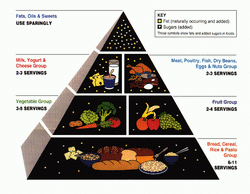
One thing I have come to realise over the years of helping people is that no amount of medication can rectify nutritional deficiencies. Consequently I test for vitamin and mineral deficiencies and offer good quality supplements to bring the body's levels back to optimal.
I have also learned that these nutrients are rather like Noah's animals going into the Ark, they like to go hand in land with other nutrients which balance them out, like iodine and selenium.
If the body is properly nourished, it can function properly, you wouldn't put diesel into a petrol car and you know that the oil is vital to keep everything well lubricated. While we are totally different from machines, there are elements that we have in common.
The Food Pyramid
In 1992 the food pyramid made its appearance and in that time the obesity and diabetes levels in the UK and US have increased exponentially.
The food pyramid advised us to consume
6-11 portions of carbohydrates a day. If carbohydrates aren't burnt off straight away for fuel the body stores them as fat with the help of the hormone insulin.
Insulin is produced in the Islets of Langerhans which make up just 2% of the pancreas. Thanks to the advice of the food pyramid, this very small part of the pancreas is on duty virtually all of the time. Over time the pancreas gets tired and does not produce enough insulin, poor quality insulin or the cells become insulin resistant and do not respond to it, allowing blood sugar levels to rise, eventually leading to Type II diabetes.
Carbohydrates should be a small part of the diet not the main core. Even 'good' complex carbohydrates convert to glucose in the body and require insulin to convert them into energy or to store them as fat.
When a respected body like the USDA endorse something like the food pyramid, it is treated like gospel and people trust it. Look where trusting this has led us, to an overweight population and a growing problem with diabetes.
This pyramid also does not differentiate between 'good fats' like Omega 3 from fish oils and linseed oil, olive oil and coconut oil which is often vilified because it is a saturated fat, please remember that not all saturated fats are bad for you.
What becomes common wisdom is not always the true picture of certain foods which are either revered or vilified.
An excellent book on this subject is by Sally Fallon and is called 'Nourishing Traditions' which debunks a lot of the current myths about the food we are advised to eat.
A very useful and informative website on this subject is that of Dr Briffa who used to have a health column in the Daily Mail.
http://www.drbriffa.comweeblylink_new_window
I have also learned that these nutrients are rather like Noah's animals going into the Ark, they like to go hand in land with other nutrients which balance them out, like iodine and selenium.
If the body is properly nourished, it can function properly, you wouldn't put diesel into a petrol car and you know that the oil is vital to keep everything well lubricated. While we are totally different from machines, there are elements that we have in common.
The Food Pyramid
In 1992 the food pyramid made its appearance and in that time the obesity and diabetes levels in the UK and US have increased exponentially.
The food pyramid advised us to consume
6-11 portions of carbohydrates a day. If carbohydrates aren't burnt off straight away for fuel the body stores them as fat with the help of the hormone insulin.
Insulin is produced in the Islets of Langerhans which make up just 2% of the pancreas. Thanks to the advice of the food pyramid, this very small part of the pancreas is on duty virtually all of the time. Over time the pancreas gets tired and does not produce enough insulin, poor quality insulin or the cells become insulin resistant and do not respond to it, allowing blood sugar levels to rise, eventually leading to Type II diabetes.
Carbohydrates should be a small part of the diet not the main core. Even 'good' complex carbohydrates convert to glucose in the body and require insulin to convert them into energy or to store them as fat.
When a respected body like the USDA endorse something like the food pyramid, it is treated like gospel and people trust it. Look where trusting this has led us, to an overweight population and a growing problem with diabetes.
This pyramid also does not differentiate between 'good fats' like Omega 3 from fish oils and linseed oil, olive oil and coconut oil which is often vilified because it is a saturated fat, please remember that not all saturated fats are bad for you.
What becomes common wisdom is not always the true picture of certain foods which are either revered or vilified.
An excellent book on this subject is by Sally Fallon and is called 'Nourishing Traditions' which debunks a lot of the current myths about the food we are advised to eat.
A very useful and informative website on this subject is that of Dr Briffa who used to have a health column in the Daily Mail.
http://www.drbriffa.comweeblylink_new_window

